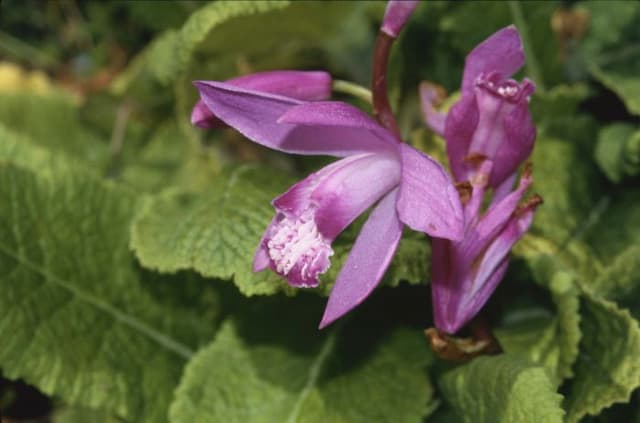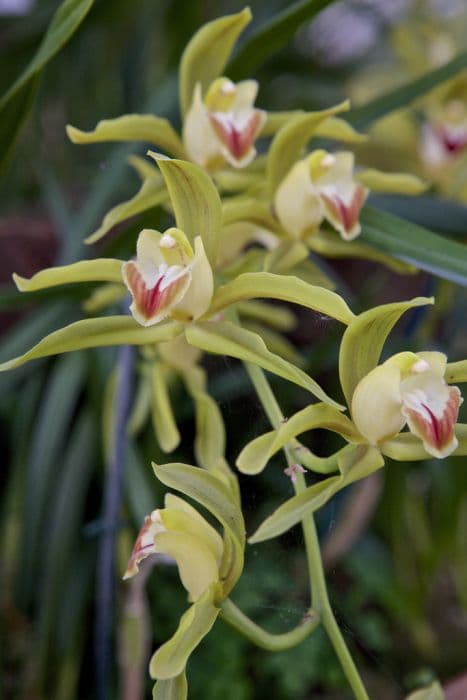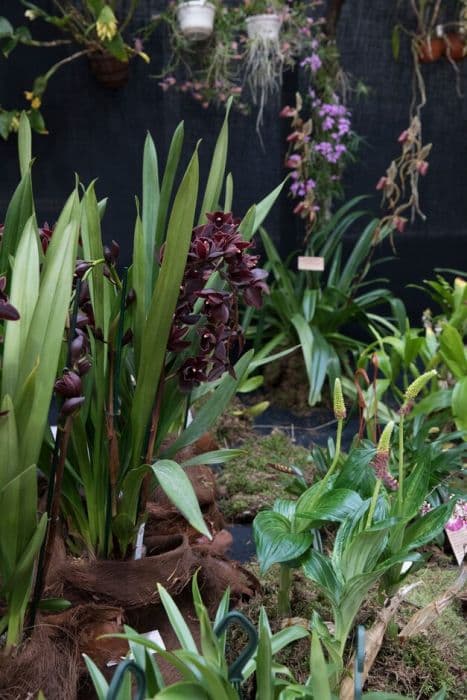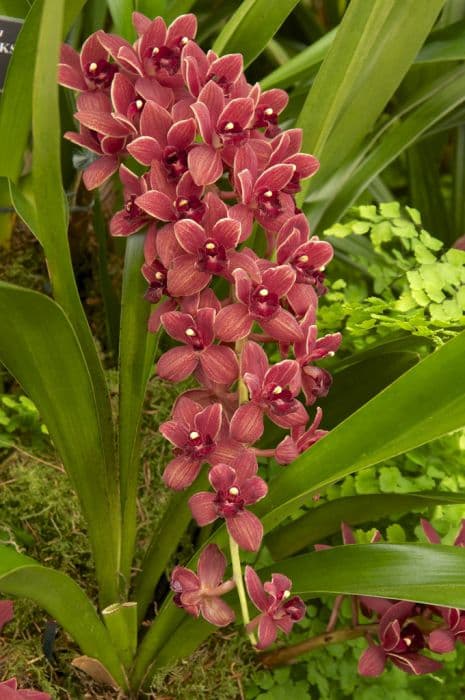Frog orchid Dactylorhiza viridis

ABOUT
The plant known most commonly as the Frog Orchid is distinctive with its variegated green appearance. It possesses a slender stem that bears a spiked inflorescence of small, typically brown-green flowers. The blossoms found on the plant are modest in size with a characteristic frog-like shape, hence its common name. Each flower is comprised of three outer segments and similar inner segments that are merged at their bases, creating a hooded structure which is quite unique. Foliage on the Frog Orchid is lance-shaped, forming a rosette at the base of the plant with leaves that can appear either spotted or plain. As the leaves ascend the stem, they become smaller and more infrequent. The texture of the leaves is also noteworthy: they are somewhat fleshy with a lightly pleated texture, giving a tactile dimension to the plant. Roots of this orchid are tuberous, with finger-like projections which serve the plant both for storage and for anchoring it in the soil. It is these tuberous roots that contribute to some of its other non-scientific names and provide it with reserves to survive in its native environments. This orchid is usually found in habitats that range from meadows to light woodland areas, showcasing its adaptability in various light and soil conditions.
About this plant
 Names
NamesFamily
Orchidaceae.
Synonyms
Frog Orchid, Green-Flowered Orchid, Long-Bracted Orchid, Green Orchis.
Common names
Coeloglossum viride, Orchis viridis, Satyrium viride
 Toxicity
ToxicityTo humans
The plant commonly known as the frog orchid (Dactylorhiza viridis) is not typically recognized for its toxicity to humans. There is limited information on the ingestion of this plant by humans, and it is generally not considered to be poisonous. However, as with any plant, individual allergies and sensitivities can occur. In general, it is not advisable to ingest any part of wild plants unless you are certain of their safety and have knowledge of their edibility.
To pets
The frog orchid (Dactylorhiza viridis) is also not known to be toxic to pets. There is little to no documentation of toxicity in domestic animals such as cats and dogs. Nevertheless, as a precaution, it's still recommended to prevent pets from ingesting plants that are not confirmed to be safe, as individual allergic reactions or gastrointestinal upset could potentially occur from consuming non-food plants.
 Characteristics
CharacteristicsLife cycle
Perennials
Foliage type
Deciduous
Color of leaves
Green
Flower color
Green
Height
1-2 feet (30-60 cm)
Spread
1 foot (30 cm)
Plant type
Herb
Hardiness zones
5
Native area
Europe
Benefits
 General Benefits
General Benefits- Ecological contribution: Dactylorhiza viridis, commonly known as the Frog Orchid, plays a role in local ecosystems by providing food in the form of nectar for pollinating insects such as bees and butterflies.
- Habitat diversity: The Frog Orchid contributes to biodiversity by adding variety to the plant species composition of the environments where it thrives, often in meadows, woodlands, and marshes.
- Aesthetic value: With its distinctive green flowers and attractive foliage, the Frog Orchid offers natural beauty and can be a feature of interest in wildflower gardens and natural landscaping designs.
- Scientific research: The Frog Orchid provides opportunities for botanical study and research, contributing to our understanding of plant biology, ecology, and evolution.
- Conservation indicator: The presence of the Frog Orchid in the wild can serve as an indicator of a healthy ecosystem, and its conservation status can help gauge the effectiveness of environmental protection measures.
- Educational tool: The Frog Orchid can be used as an educational tool to raise awareness about plant diversity, conservation issues, and the importance of habitat protection.
 Medical Properties
Medical Properties- This plant is not used for medical purposes.
 Air-purifying Qualities
Air-purifying QualitiesThis plant is not specifically known for air purifying qualities.
 Other Uses
Other Uses- Dactylorhiza viridis, commonly known as the frog orchid, can be used in ecological studies as an indicator species for identifying the health of wetland ecosystems due to its sensitivity to environmental changes.
- The roots of the frog orchid can be used for dye extraction, providing a source of natural colors for textiles and other materials.
- The plant has been used as an ornamental in shade gardens or naturalized woodland settings, contributing to the aesthetic value and biodiversity.
- Insects, particularly certain species of butterflies and moths, can utilize the frog orchid as a nectar source, and planting it can aid in supporting local pollinator populations.
- The leaves of the frog orchid can be used in creating botanical prints due to the detailed veining, which can leave intricate patterns on fabrics or papers.
- This orchid can be used in environmental education programs to illustrate the importance of conservation efforts for native orchid species and their habitats.
- When planted in proximity to crops, Dactylorhiza viridis may play a role in integrated pest management by attracting and sustaining populations of beneficial insects.
- The frog orchid can be used in artistic endeavors, such as photography or drawing, as subject matter due to its distinctive appearance and vibrant green coloration.
- It can be included in wildflower seed mixes to promote biodiversity and landscape restoration projects for degraded lands.
- Amateur and professional botanists may collect and preserve specimens of the frog orchid for herbarium contributions to document and study floral diversity.
Interesting Facts
 Feng Shui
Feng ShuiThe Frog Orchid is not used in Feng Shui practice.
 Zodiac Sign Compitability
Zodiac Sign CompitabilityThe Frog Orchid is not used in astrology practice.
 Plant Symbolism
Plant Symbolism- Rarity: The Frog Orchid, as Dactylorhiza viridis is commonly known, is quite rare in some regions, symbolizing uniqueness and the preciousness of scarce things.
- Adaptability: Orchids are known for their ability to adapt to different environments, with the Frog Orchid representing resilience and flexibility.
- Beauty and Grace: Despite its common name, the Frog Orchid possesses an understated elegance, symbolizing beauty, sophistication, and a delicate allure.
- Mystery: Orchids, in general, are often associated with mystery because of their exotic appearance and the Frog Orchid is no exception, representing enigma and the unknown.
 Water
WaterFor the Frog Orchid (Dactylorhiza viridis), it's essential to keep the soil consistently moist but not waterlogged. During the active growing season in spring and summer, water the plant thoroughly, allowing the water to run through the pot, every 5 to 7 days. It may need less frequent watering during the dormant season in fall and winter, approximately every 10 to 14 days. When you water, use approximately 8 to 16 ounces of water, depending on the pot size and the soil moisture level. Always check the top inch of the soil for dryness before watering again.
 Light
LightThe Frog Orchid prefers bright, indirect light. The ideal spot for this plant would be in an east-facing window where it can receive gentle morning sunlight. Avoid direct afternoon sun, which can scorch the leaves. If natural light is limited, a grow light can be used to supplement light exposure.
 Temperature
TemperatureThe Frog Orchid thrives in a temperature range between 50°F and 70°F, with an ideal temperature around 65°F. Temperatures above 75°F can stress the plant, while it can survive short periods down to around 40°F. Avoid placing the plant in areas with drafts or sudden temperature changes.
 Pruning
PruningPruning the Frog Orchid primarily involves removing dead or yellowing leaves to encourage healthy growth and prevent disease. Prune after the flowering period or when necessary throughout the year. Use sterilized pruning shears or scissors to make clean cuts, and avoid cutting any healthy tissue to prevent stress to the plant.
 Cleaning
CleaningAs needed
 Soil
SoilThe Frog orchid thrives in a soil mix with high organic content, typically composed of fine bark, perlite, and peat moss, with good drainage to prevent root rot. The ideal soil pH for Frog orchid should be slightly acidic to neutral, ranging from 6.0 to 7.0.
 Repotting
RepottingFrog orchids should be repotted every one to two years to refresh the soil and accommodate root growth, ideally during late winter or early spring just before new growth begins.
 Humidity & Misting
Humidity & MistingFrog orchids prefer high humidity levels, typically between 60% to 80%, which help mimic their natural boggy and marshy habitat conditions.
 Suitable locations
Suitable locationsIndoor
Use bright, indirect light, maintain high humidity, and use airy soil mix for Frog orchid.
Outdoor
Plant in part-shade, create moist conditions, and protect from strong winds for Frog orchid.
Hardiness zone
4-9 USDA for Frog orchid.
 Life cycle
Life cycleThe Frog Orchid (Dactylorhiza viridis), begins its life cycle as a seed released from the parent plant in late summer, dispersing into the soil. It enters a symbiotic relationship with mycorrhizal fungi, which is crucial for the seed to germinate and develop the initial underground structures. Upon successful establishment, a rosette of leaves emerges in spring, followed by a flowering stem that blooms from May to July, depending on the climate. Each flower has the potential to be pollinated by insects, leading to seed development and dispersal. After flowering, the above-ground parts begin to wither while the tuberous rootstock survives underground. The plant remains dormant through the winter, with the cycle beginning anew with the growth of new leaves in the next spring.
 Propogation
PropogationPropogation time
Spring to summer
The most popular method of propagation for the Green-winged Orchid, officially known as Dactylorhiza viridis, is through seed sowing. Propagation time is best during the fall or early spring when temperatures are mild. Orchid seeds are incredibly tiny and dust-like, making them challenging to handle. To sow the seeds, they should be scattered on the surface of a finely textured, well-draining orchid potting mix. After sowing, the surface needs to be kept moist but not waterlogged, as excessive moisture can lead to fungal problems that could damage or kill the tiny seedlings. The seeds require a symbiotic relationship with a specific type of fungus to successfully germinate, so it's crucial that the growing medium is inoculated with the appropriate mycorrhizal fungi. Once germinated, seedlings are slow-growing and may take several years to flower.









